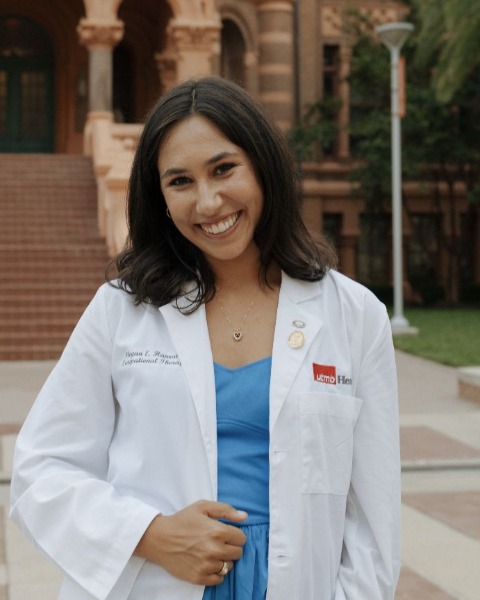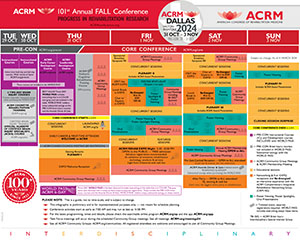Behavioral Health Sciences
Clinical Practice
“Fitness and Function,” a Stress Management Intervention for the Houseless Population
Friday, November 1, 2024
12:15 PM - 12:30 PM
Location: Station 3: ROOM: POSTERLAND / Trinity Poster / Exhibit Hall REGION: Tower Lobby Level >>>

Megan Hanratty, mehanrat@utmb.edu (she/her/hers)
Occupational Therapy Doctoral Student, Robert K. Bing Scholarship Recipient
University of Texas Medical Branch
Houston, Texas, United States
Presenting Author(s)
Research Objectives: To investigate the effect of a stress management intervention on the quality of life of the unhoused and low socioeconomic population.
Design: This was a community-outreach project utilizing mixed methods data following a stress management intervention with survey data.
Setting: Galveston Central Church (GCC), which collaborates with the Galveston community to provide warm meals, shelter, showers, laundry machines, a multi-disciplinary clinic, and a bike repair shop for those who are houseless and low socioeconomic status in Galveston.
Participants: Human subjects who were houseless and low socioeconomic status community members at GCC.
Interventions: This intervention consisted of an in-person weekly group fitness class targeting the houseless community members at GCC for six weeks and incorporated movement and promotion of stress management education among the houseless individuals at GCC who lack resources, fitness knowledge, and meaningful occupation. It incorporated a 45-minute low-load group fitness class led by graduate student volunteers with 15 minutes of education on one stress management technique and application incorporated into the program. All graduate volunteers completed volunteer training involving explanation of volunteer responsibilities, understanding the houseless population, and addressing exercise safety.
Main Outcome Measures: Volunteers and group members were surveyed. The volunteer survey tool identified site familiarity, volunteer preparation, the role of occupational therapy with the unhoused population, and program improvements. A survey tool was implemented at the end of each class to capture group member satisfaction and identify what members enjoyed, how they benefitted, and suggestions for improving the current program.
Results: All volunteers felt the volunteer program covered everything they needed to know. Volunteers reported the most helpful parts being the overview of content, exercise safety, role breakdown, and volunteer expectations. Volunteer suggestions for improvements included outside sessions, more community introductions before each session, and further program promotion to individuals. Volunteers reported an increased understanding of the benefits of socialization and self-regulation strategies in the unhoused community.
An estimated 34 total community members attended with an average of eight per session. Majority of participants reported a decrease in stress levels or stable stress levels each session. Qualitative responses included improved self-care (through stretching & breathing), community participation, and stress relief. Community leaders reported differences seen in the community.
Conclusions: Volunteers reported an increased understanding of OT's role among the unhoused population. Houseless participants reported improved movement, social interaction, and well-being after participating in this stress management intervention.
Author(s) Disclosures: This project was completed with funding from the Robert K. Bing Scholarship. No conflicts of interest to disclose.
Design: This was a community-outreach project utilizing mixed methods data following a stress management intervention with survey data.
Setting: Galveston Central Church (GCC), which collaborates with the Galveston community to provide warm meals, shelter, showers, laundry machines, a multi-disciplinary clinic, and a bike repair shop for those who are houseless and low socioeconomic status in Galveston.
Participants: Human subjects who were houseless and low socioeconomic status community members at GCC.
Interventions: This intervention consisted of an in-person weekly group fitness class targeting the houseless community members at GCC for six weeks and incorporated movement and promotion of stress management education among the houseless individuals at GCC who lack resources, fitness knowledge, and meaningful occupation. It incorporated a 45-minute low-load group fitness class led by graduate student volunteers with 15 minutes of education on one stress management technique and application incorporated into the program. All graduate volunteers completed volunteer training involving explanation of volunteer responsibilities, understanding the houseless population, and addressing exercise safety.
Main Outcome Measures: Volunteers and group members were surveyed. The volunteer survey tool identified site familiarity, volunteer preparation, the role of occupational therapy with the unhoused population, and program improvements. A survey tool was implemented at the end of each class to capture group member satisfaction and identify what members enjoyed, how they benefitted, and suggestions for improving the current program.
Results: All volunteers felt the volunteer program covered everything they needed to know. Volunteers reported the most helpful parts being the overview of content, exercise safety, role breakdown, and volunteer expectations. Volunteer suggestions for improvements included outside sessions, more community introductions before each session, and further program promotion to individuals. Volunteers reported an increased understanding of the benefits of socialization and self-regulation strategies in the unhoused community.
An estimated 34 total community members attended with an average of eight per session. Majority of participants reported a decrease in stress levels or stable stress levels each session. Qualitative responses included improved self-care (through stretching & breathing), community participation, and stress relief. Community leaders reported differences seen in the community.
Conclusions: Volunteers reported an increased understanding of OT's role among the unhoused population. Houseless participants reported improved movement, social interaction, and well-being after participating in this stress management intervention.
Author(s) Disclosures: This project was completed with funding from the Robert K. Bing Scholarship. No conflicts of interest to disclose.
Learning Objectives:
- Identify the need for stress management interventions among the houseless population.
- Describe OT’s potential role among the persons experiencing houselessness and low socioeconomic status.
- Describe the importance of socialization and the benefits of movement among the houseless population for preventative care.

.jpg)
.jpg)
.jpg)
